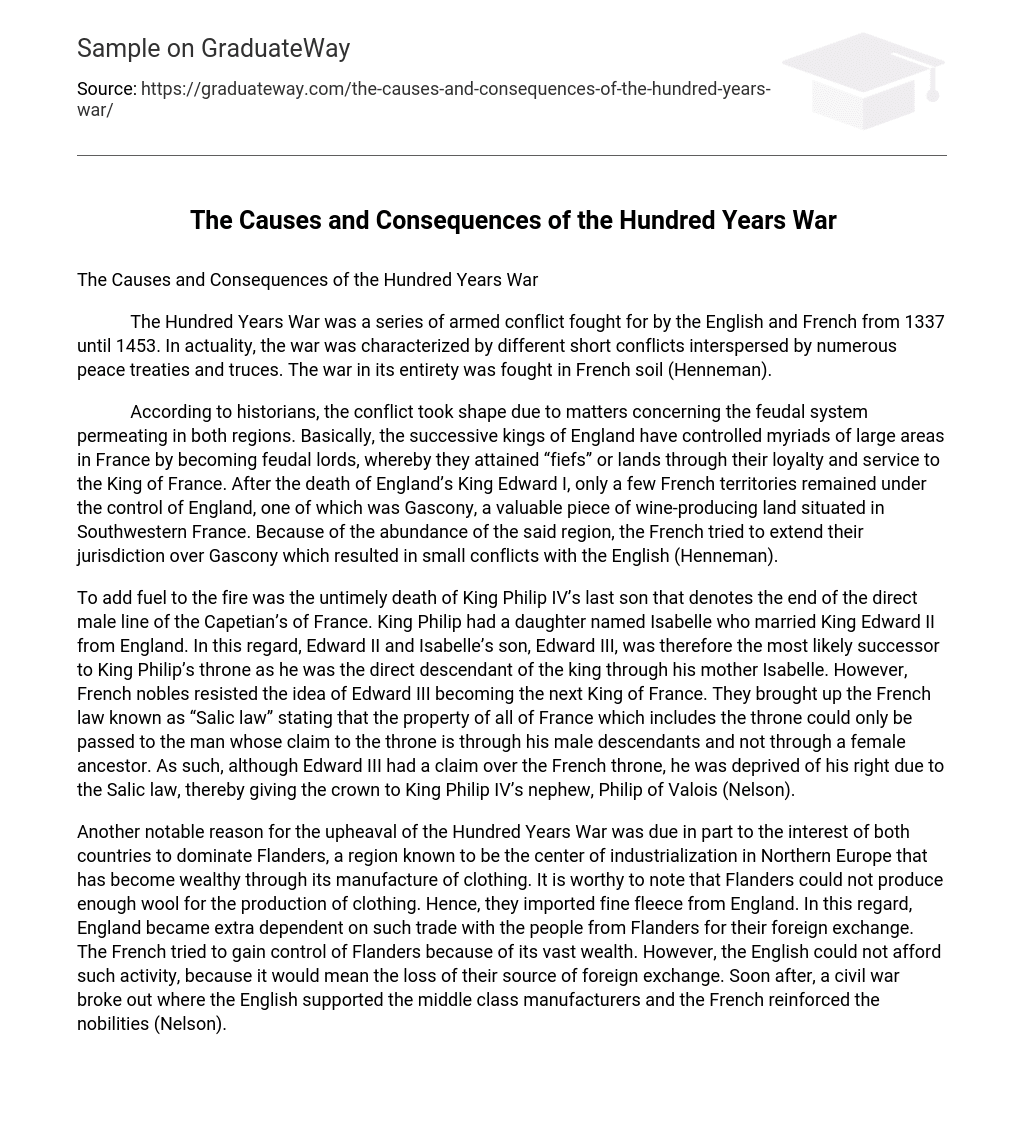The Hundred Years War was a series of armed conflict fought for by the English and French from 1337 until 1453. In actuality, the war was characterized by different short conflicts interspersed by numerous peace treaties and truces. The war in its entirety was fought in French soil (Henneman).
According to historians, the conflict took shape due to matters concerning the feudal system permeating in both regions. Basically, the successive kings of England have controlled myriads of large areas in France by becoming feudal lords, whereby they attained “fiefs” or lands through their loyalty and service to the King of France. After the death of England’s King Edward I, only a few French territories remained under the control of England, one of which was Gascony, a valuable piece of wine-producing land situated in Southwestern France. Because of the abundance of the said region, the French tried to extend their jurisdiction over Gascony which resulted in small conflicts with the English (Henneman).
To add fuel to the fire was the untimely death of King Philip IV’s last son that denotes the end of the direct male line of the Capetian’s of France. King Philip had a daughter named Isabelle who married King Edward II from England. In this regard, Edward II and Isabelle’s son, Edward III, was therefore the most likely successor to King Philip’s throne as he was the direct descendant of the king through his mother Isabelle. However, French nobles resisted the idea of Edward III becoming the next King of France. They brought up the French law known as “Salic law” stating that the property of all of France which includes the throne could only be passed to the man whose claim to the throne is through his male descendants and not through a female ancestor. As such, although Edward III had a claim over the French throne, he was deprived of his right due to the Salic law, thereby giving the crown to King Philip IV’s nephew, Philip of Valois (Nelson).
Another notable reason for the upheaval of the Hundred Years War was due in part to the interest of both countries to dominate Flanders, a region known to be the center of industrialization in Northern Europe that has become wealthy through its manufacture of clothing. It is worthy to note that Flanders could not produce enough wool for the production of clothing. Hence, they imported fine fleece from England. In this regard, England became extra dependent on such trade with the people from Flanders for their foreign exchange. The French tried to gain control of Flanders because of its vast wealth. However, the English could not afford such activity, because it would mean the loss of their source of foreign exchange. Soon after, a civil war broke out where the English supported the middle class manufacturers and the French reinforced the nobilities (Nelson).
The costs of Hundred Years’ War were far reaching for each region. However, since the war was waged in the French soil, it affected France in many ways. Likewise, it posted little, yet significant effects on England. The war marked the end of the English’s control over continental territory; instead, it gave emphasis on maritime supremacy which further strengthened the Parliament system of the country. Right after the marriage of Henry V to the House of Valois, the English royal family was then plagued with hereditary strain of mental disorders. Other than these, very little changes were seen in the lifestyle of an average English man (Nelson).
Meanwhile, the major impact of war was seen on France. Over an extended period, there was a great loss of life and destruction of properties. One example was the revolt of the peasants and the townspeople. After the loss of French in the war during 1358, the peasants blamed the nobles for the loss. The revolt was known as the Jacquerie. The peasants burned the houses and cost the lives of many noble families. In return, the nobles met the peasants with equal savagery. The social consequence of such action was the birth of French middle class. Despite all these, one of the most notable effects of the war was the rise of French nationalism as seen through the actions of Joan of Arc, who inspired the idea among other French. France also acquired superiority in terms of utilizing firearms most especially in the field of artillery and the emergence of institutions that are governed in a centralized manner as well as stability in coinage and the regularization of taxes (Henneman).
Ultimately, the end of Hundred Years’ War put an end in the economic issues and the decline in the population of both France and England. Likewise, the people of both regions perceived themselves as “separate and distinctive nationalities,” and are not just a part of a feudal empire (Henneman).
Generally, the emergence of the Hundred Years’ War were rooted in various aspects but were centered mostly on the feudal system of the land as well as the attainment of power. Because of this, different aspects of the English and French society were impacted both in positive and negative ways. Hence, the contributions of the Hundred Years’ War in the development of present day Europe cannot be overlooked.
Works Cited
Henneman, John Bell. “Hundred Years’ War.” Microsoft Encarta Online Encyclopedia.
2008. 16 December 2008
<http://encarta.msn.com/text_761560546___0/Hundred_Years%E2%80%99_War. html>.
Nelson, Lynn Harry. “The Hundred Years’ War, 1336-1453.” University of Kansas
Virtual Library. 2008. 16 December 2008
<http://www.vlib.us/medieval/lectures/hundred_years_war.html>.





